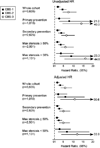Usefulness of cardiac biomarker score for risk stratification in stable patients undergoing elective cardiac evaluation across glycemic status
- PMID: 23219176
- PMCID: PMC3641751
- DOI: 10.1016/j.amjcard.2012.10.027
Usefulness of cardiac biomarker score for risk stratification in stable patients undergoing elective cardiac evaluation across glycemic status
Abstract
Several clinically available cardiac biomarkers have established their prognostic value in patients with acute coronary syndromes. However, their relative prognostic significance in stable subjects has not been prospectively validated, either individually or in combination. The aim of this study was to evaluate the extent to which B-type natriuretic peptide, myeloperoxidase, and high-sensitivity C-reactive protein alone or together could be prognostic biomarkers in 3,635 consecutive stable patients without acute coronary syndrome who underwent elective diagnostic coronary angiography. After adjusting for traditional risk factors and renal function, each of the markers monitored was a significant predictor of incident major adverse cardiovascular events (death, nonfatal myocardial infarction, and stroke) over 3 years. A cardiac biomarker score based on the sum total of "positive" biomarkers provided independent prediction of future risk for incident major adverse cardiovascular events at 3 years (hazard ratio [HR] 7.61, 95% confidence interval [CI] 4.98 to 11.65, p <0.001), even after adjusted for traditional risk factors (HR 6.11, 95% CI 3.98 to 9.38, p <0.001). A positive cardiac biomarker score remained a strong and independent predictor of 3-year risk for major adverse cardiovascular events among those with normal glycemic control (HR 4.24, 95% CI 1.96 to 9.18, p <0.001), those with prediabetes (HR 7.62, 95% CI 3.87 to 15.01, p <0.001), and those with diabetes (HR 5.61, 95% CI 2.55 to 12.33, p <0.001), as well as within subjects without significant angiographic evidence of coronary artery disease (HR 10.82, 95% CI 3.82 to 30.6, p <0.001). In conclusion, an integrated assessment of cardiac biomarkers may provide independent prognostic value for long-term adverse clinical events in stable cardiac patients.
Copyright © 2013 Elsevier Inc. All rights reserved.
Figures



Similar articles
-
Plasma myeloperoxidase predicts incident cardiovascular risks in stable patients undergoing medical management for coronary artery disease.Clin Chem. 2011 Jan;57(1):33-9. doi: 10.1373/clinchem.2010.152827. Epub 2010 Nov 8. Clin Chem. 2011. PMID: 21059827 Free PMC article.
-
Risk stratification in stable coronary artery disease: superiority of N-terminal pro B-type natriuretic peptide over high-sensitivity C-reactive protein, gamma-glutamyl transferase, and traditional risk factors.Coron Artery Dis. 2012 Mar;23(2):91-7. doi: 10.1097/MCA.0b013e32834f1165. Coron Artery Dis. 2012. PMID: 22157356
-
High-sensitivity troponin I and B-type natriuretic peptide biomarkers for prediction of cardiovascular events in patients with coronary artery disease with and without diabetes mellitus.Cardiovasc Diabetol. 2019 Dec 17;18(1):171. doi: 10.1186/s12933-019-0974-2. Cardiovasc Diabetol. 2019. PMID: 31847896 Free PMC article.
-
Evaluating the quality of research into a single prognostic biomarker: a systematic review and meta-analysis of 83 studies of C-reactive protein in stable coronary artery disease.PLoS Med. 2010 Jun 1;7(6):e1000286. doi: 10.1371/journal.pmed.1000286. PLoS Med. 2010. PMID: 20532236 Free PMC article. Review.
-
Biomarker tests for risk assessment in coronary artery disease: will they change clinical practice?Mol Diagn Ther. 2014 Feb;18(1):5-15. doi: 10.1007/s40291-013-0057-0. Mol Diagn Ther. 2014. PMID: 24072397 Review.
Cited by
-
Low Levels of Adropin Predict Adverse Clinical Outcomes in Outpatients with Newly Diagnosed Prediabetes after Acute Myocardial Infarction.Biomedicines. 2024 Aug 15;12(8):1857. doi: 10.3390/biomedicines12081857. Biomedicines. 2024. PMID: 39200321 Free PMC article.
-
The roles of myeloperoxidase in coronary artery disease and its potential implication in plaque rupture.Redox Rep. 2017 Mar;22(2):51-73. doi: 10.1080/13510002.2016.1256119. Epub 2016 Nov 25. Redox Rep. 2017. PMID: 27884085 Free PMC article. Review.
-
Predictive value of baseline C-reactive protein level in patients with stable coronary artery disease: A meta-analysis.Medicine (Baltimore). 2022 Sep 2;101(35):e30285. doi: 10.1097/MD.0000000000030331. Medicine (Baltimore). 2022. PMID: 36107517 Free PMC article.
-
NT-proBNP and cardiovascular event risk in individuals with prediabetes undergoing cardiovascular evaluation.Diabetes Res Clin Pract. 2023 Nov;205:110923. doi: 10.1016/j.diabres.2023.110923. Epub 2023 Sep 27. Diabetes Res Clin Pract. 2023. PMID: 37774978 Free PMC article.
-
Myeloperoxidase as a Promising Therapeutic Target after Myocardial Infarction.Antioxidants (Basel). 2024 Jun 28;13(7):788. doi: 10.3390/antiox13070788. Antioxidants (Basel). 2024. PMID: 39061857 Free PMC article. Review.
References
-
- Sabatine MS, Morrow DA, de Lemos JA, Gibson CM, Murphy SA, Rifai N, McCabe C, Antman EM, Cannon CP, Braunwald E. Multi-marker approach to risk stratification in non-ST elevation acute coronary syndromes: simultaneous assessment of troponin I, C-reactive protein, and B-type natriuretic peptide. Circulation. 2002;105:1760–1763. - PubMed
-
- de Lemos JA, Morrow DA, Bentley JH, Omland T, Sabatine MS, McCabe CH, Hall C, Cannon CP, Braunwald E. The prognostic value of B-type natriuretic peptide in patients with acute coronary syndromes. N Engl J Med. 2001;345:1014–1021. - PubMed
-
- Brennan ML, Penn MS, VanLente F, Nambi V, Shishehbor MH, Aviles RJ, Goormastic M, Pepoy ML, McErlean ES, Topol EJ, Nissen SE, Hazen SL. Prognostic value of myeloperoxidase in patients with chest pain. N Engl J Med. 2003;349:1595–1604. - PubMed
-
- Ridker PM, Hennekens CH, Buring JE, Rifai N. C-reactive protein and other markers of inflammation in the prediction of cardiovascular disease in women. N Engl J Med. 2000;342:836–843. - PubMed
-
- Morrow DA, Braunwald E. Future of biomarkers in acute coronary syndromes: moving toward a multimarker strategy. Circulation. 2003;108:250–252. - PubMed
Publication types
MeSH terms
Substances
Grants and funding
- P01 HL087018/HL/NHLBI NIH HHS/United States
- UL1 RR024989/RR/NCRR NIH HHS/United States
- P01HL087018-020001/HL/NHLBI NIH HHS/United States
- 1UL1RR024989/RR/NCRR NIH HHS/United States
- P01 HL076491/HL/NHLBI NIH HHS/United States
- P20 HL113452/HL/NHLBI NIH HHS/United States
- U10 HL109250/HL/NHLBI NIH HHS/United States
- P01 HL098055/HL/NHLBI NIH HHS/United States
- UL1 TR000439/TR/NCATS NIH HHS/United States
- P01 HL103453/HL/NHLBI NIH HHS/United States
- 1R01HL103931/HL/NHLBI NIH HHS/United States
- 1R01HL103866/HL/NHLBI NIH HHS/United States
- R01 HL103931/HL/NHLBI NIH HHS/United States
- R01 HL103866/HL/NHLBI NIH HHS/United States
- P01HL076491-055328/HL/NHLBI NIH HHS/United States
LinkOut - more resources
Full Text Sources
Other Literature Sources
Medical
Research Materials

